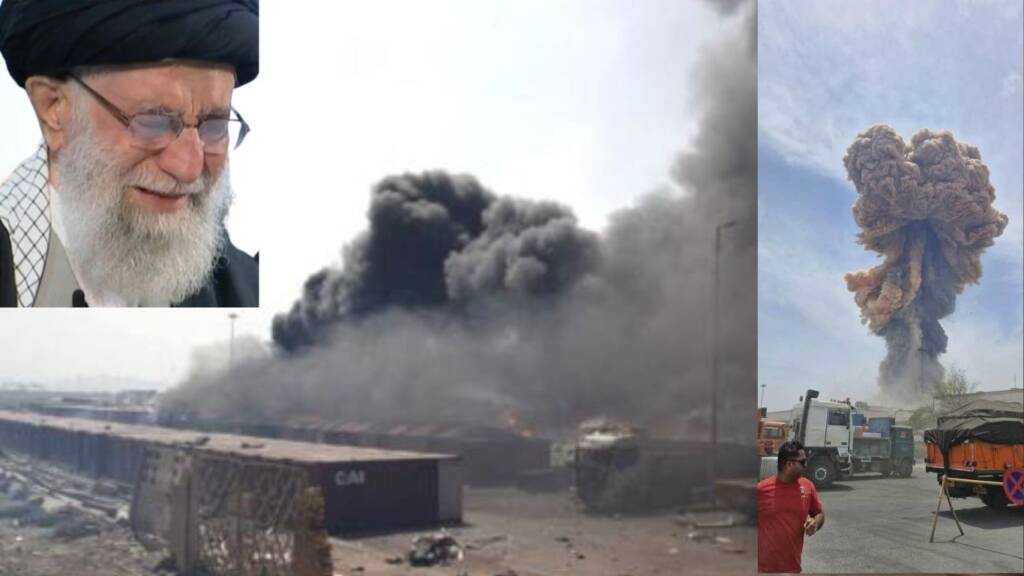A huge explosion rocked the Shahid Rajaee port near Iran’s Bandar Abbas city on Saturday, killing at least five people and injuring more than 700, according to Iranian state media. The numbers are expected to increase with time. Port activities were immediately suspended as emergency teams battled the ensuing fire and worked to rescue the injured.
The blast, which shattered windows several kilometres away, originated from several containers stored in the port’s wharf area. Initial reports suggest that the containers likely contained chemicals, though the precise cause of the explosion remains under investigation. Involvement of other nations or groups cannot be ruled out. Press TV reported that an administrative building was completely destroyed, and numerous vehicles were severely damaged in the blast.
Meanwhile the Washington Post has reported that Israel was likely behind that attack in retaliation for an earlier Iranian cyberattack. Previously, Shahid Rajaee port had also been targeted by a cyberattack that caused significant backups in the surrounding areas.
“The cause of this incident was the explosion of several containers stored in the Shahid Rajaee Port wharf area. We are currently evaluating and transferring the injured to medical centres,” a local crisis management official told state TV.
Fatemeh Mohajerani, the government spokeswoman, indicated that improperly stored chemical materials could have contributed to the disaster. Meanwhile, the Iranian government has dispatched twenty rapid response teams, five helicopters, and medical personnel from neighbouring provinces to assist in relief efforts. Medical centres in Hormozgan, Fars, Kerman, and even Tehran have been placed on high alert. This shows the exact amount of damage that explosion must have done.
Iran’s President Masoud Pezeshkian expressed profound sorrow over the tragedy and offered condolences to the families of the victims. First Vice-President Mohammad-Reza Aref has ordered an immediate and comprehensive investigation into the cause of the explosion and the full extent of the damage.
Authorities, including Interior Minister Eskandar Momeni and Red Crescent chief Pirhossein Kolivand, have arrived at the scene to oversee the ongoing relief efforts. The Emergency Operations Center is actively coordinating the real-time monitoring of rescue operations.
Importantly, the National Iranian Oil Refining and Distribution Company has clarified that no refineries, fuel tanks, distribution centers, or oil pipelines were affected, ensuring that oil operations in the region continue without disruption.
A Port of Critical Global Importance
Shahid Rajaee port is located around 15 kilometres southwest of Bandar Abbas on the northern shore of the Strait of Hormuz. The port lies about 1,050 kilometres southeast of Tehran. It holds immense geopolitical significance. Situated near the narrow waterway through which roughly 20 percent of the world’s oil supply is shipped, the port is one of Iran’s largest and most strategically vital trade hubs.
Any disruption at Shahid Rajaee port has the potential to ripple across global energy markets and commercial shipping lanes. In 2020, the port was previously targeted in a cyberattack, reportedly linked to Israel, highlighting its vulnerability in the broader shadow conflict involving Iran, the US, and regional powers.
Timing of the Blast is raised concern
The explosion comes at a sensitive time, as Iran is engaged in a third round of nuclear negotiations with the United States in Oman. US special envoy Steve Witkoff and Iranian Foreign Minister Abbas Araghchi are leading the talks, aiming to revive an agreement that would prevent Iran from developing nuclear weapons—a charge Tehran denies—in exchange for relief from US-led sanctions.
While no direct link between the explosion and the ongoing talks has been established, the timing has fueled speculation about potential sabotage or broader regional instability. Iranian officials, however, have so far treated the blast as an industrial accident. However, the link to Israeli involvement can not be ruled out at this point of time. Further, the investigation will clear the cloud that this is an accident caused by the chemical material or a deliberate act of attack in order to derail the ongoing nuclear talks.
Araghchi, commenting earlier this week, had expressed “cautious optimism” about the talks but warned of obstacles if Washington made “impractical or illogical demands.” Against this backdrop, any incident affecting Iran’s critical infrastructure could influence diplomatic dynamics.
As investigations continue, the Shahid Rajaee explosion serves as a stark reminder of the vulnerabilities that can escalate tensions in an already fragile region of West Asia.
